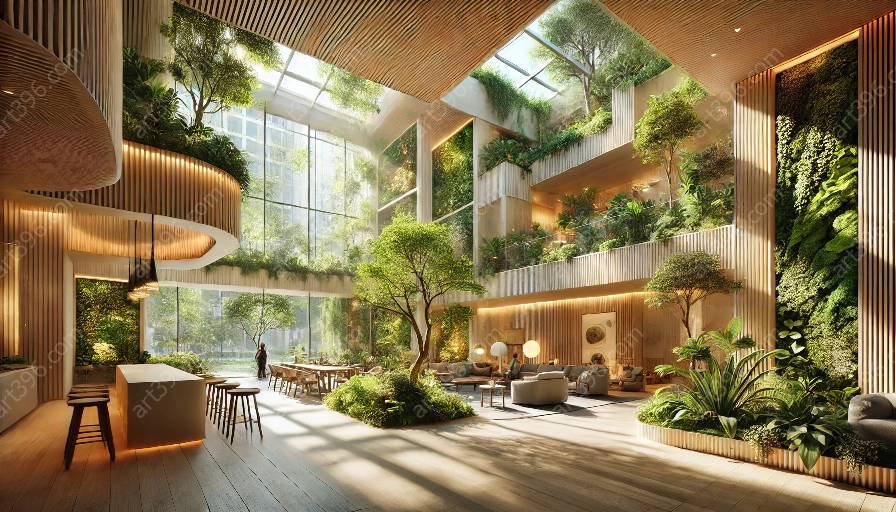Biophilic design in architecture emphasizes the connection between humans and nature, seeking to incorporate natural elements into the built environment. This design approach has gained significant attention for its potential to promote well-being, sustainability, and environmental consciousness. However, the successful implementation of biophilic design often requires interdisciplinary collaboration, where professionals from various fields contribute their expertise to create harmonious and impactful architectural solutions.
Understanding Biophilic Design in Architecture
Before delving into the role of interdisciplinary collaboration, it's crucial to grasp the essence of biophilic design in architecture. Biophilic design encompasses the use of natural elements, organic patterns, and processes to create spaces that support human health and well-being. It aims to foster an environment where people feel connected to nature, even in urban settings. By integrating natural light, ventilation, and greenery, biophilic design seeks to enhance the overall quality of life for building occupants while promoting sustainability.
The Interdisciplinary Nature of Biophilic Design
Biophilic design draws from a range of disciplines, including architecture, psychology, biology, ecology, and urban planning. Each of these fields contributes unique insights and skills to the development of biophilic architectural solutions. Architects bring their expertise in spatial design and construction, understanding how to integrate natural elements into buildings while ensuring structural integrity and functionality.
Psychologists and biologists offer valuable perspectives on human-nature interaction, considering how elements such as natural light, water features, and greenery can positively impact human behavior, mood, and cognitive function. Ecologists provide insights into biodiversity and ecosystem dynamics, guiding the selection of plant species and the incorporation of sustainable landscaping practices.
Urban planners contribute by considering the broader urban context in which biophilic designs are implemented. They explore how these designs can enhance public spaces, mitigate the urban heat island effect, and contribute to overall urban resilience. Together, these diverse disciplines form the foundation for an interdisciplinary approach to biophilic design.
Advancing Biophilic Design through Interdisciplinary Collaboration
Interdisciplinary collaboration plays a vital role in advancing biophilic design in architecture in several key ways. Firstly, it enables a holistic understanding of the complex interactions between humans, built environments, and nature. By bringing together experts from diverse fields, architects can gain insights that inform their design decisions, ensuring that biophilic elements are thoughtfully integrated to achieve the desired outcomes.
Secondly, interdisciplinary collaboration promotes innovation by encouraging the exchange of ideas and cross-disciplinary problem-solving. When architects, biologists, psychologists, and other professionals collaborate, they can explore unconventional approaches that go beyond traditional architectural practices. This fosters creativity and the development of novel solutions that maximize the benefits of biophilic design.
Case Studies of Successful Interdisciplinary Collaboration
Several notable architectural projects showcase the power of interdisciplinary collaboration in advancing biophilic design. The Amazon Spheres in Seattle, Washington, exemplify a harmonious blend of nature and architecture, featuring a unique design that integrates plant-filled spheres within a bustling urban environment. This project involved collaboration between architects, biologists, and horticulturists to create a living workspace that supports employee well-being and environmental sustainability.
Similarly, the Bosco Verticale towers in Milan, Italy, stand as a testament to the collaborative efforts of architects, botanists, and sustainability experts. These residential towers are adorned with a diverse array of plant species, contributing to air purification, energy efficiency, and visual appeal. The success of these projects underscores the importance of interdisciplinary collaboration in realizing the full potential of biophilic design.
Challenges and Future Opportunities
Despite its many benefits, interdisciplinary collaboration in biophilic design also presents challenges, including the need for effective communication and coordination among diverse professionals. Overcoming disciplinary boundaries and fostering mutual understanding requires intentional efforts and strong leadership. However, the potential rewards of such collaboration are evident in the creation of innovative, sustainable, and human-centered architectural spaces.
In the future, the role of interdisciplinary collaboration in advancing biophilic design is poised to expand further. As new findings emerge from fields such as neuroscience, biomimicry, and sustainable design, architects and their collaborators will have even greater opportunities to push the boundaries of biophilic design, creating environments that seamlessly integrate with and benefit from natural systems.
Conclusion
Interdisciplinary collaboration is a cornerstone of advancing biophilic design in architecture. By embracing the collective wisdom of various disciplines, architects can create environments that not only reflect our innate connection to nature but also contribute to a more sustainable and harmonious built environment. As the practice of biophilic design continues to evolve, interdisciplinary collaboration will remain essential for unlocking its full potential and shaping the future of architecture.

















































































